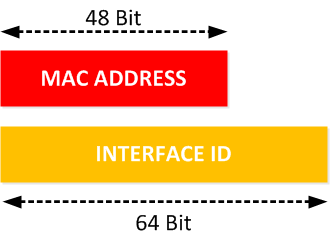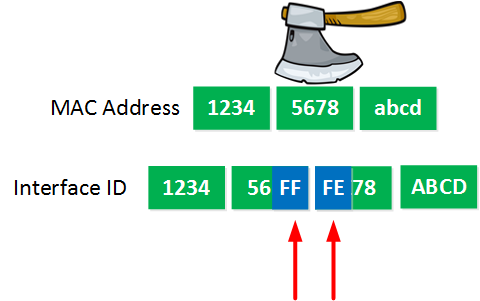Lesson Contents
EUI-64 (Extended Unique Identifier) is a method that automatically generates the 64-bit interface ID portion of an IPv6 address using a device’s 48-bit MAC address. This way, you don’t have to configure IPv6 addresses manually on every interface, and each IPv6 address will be unique. In this lesson, I’ll explain how EUI-64 converts a 48-bit MAC address into a 64-bit IPv6 address, and I’ll show you how to configure this on Cisco IOS.
Key Takeaways
- EUI-64 automatically generates the 64-bit interface ID from a 48-bit MAC address
- The conversion inserts FFFE between the two halves of the MAC address
- The 7th bit of the first byte is inverted (flipped from 0 to 1, or 1 to 0)
- Configure with the:
ipv6 address <prefix>/64 eui-64command - If an interface lacks a MAC address, the router uses the MAC from the lowest-numbered interface
- The 7th bit represents the universal/local bit. Built-in MAC addresses have this set to 0
Prerequisites
To follow this lesson, you should understand the basics of IPv6.
Explanation
We can use EUI-64 to configure IPv6 host addresses automatically. An IPv6 device will use the MAC address of its interface to generate a unique 64-bit interface ID. However, a MAC address is 48 bits and the interface ID is 64 bits. What are we going to do with the missing bits?

Here’s what we will do to fill the missing bits:
-
- We take the MAC address and split it into two pieces.
- We insert “FFFE” in between the two pieces so that we have a 64 bit value.
- We invert the 7th bit of the interface ID.
So if my MAC address would be 1234.5678.ABCD then this is what the interface ID will become:

Above you see how we split the MAC address and put FFFE in the middle. It doesn’t include the final step which is “inverting the 7th” bit. To do this you have to convert the first two hexadecimal characters of the first byte to binary, lookup the 7th bit and invert it. This means that if it’s a 0 you need to make it a 1, and if it’s a 1 it has to become a 0.
The 7th bit represents the universal unique bit. A “built in” MAC address will always have this bit set to 0. When you change the MAC address this bit has to be set to 1. Normally people don’t change the MAC addresses of their interfaces which means that EUI-64 will change the 7th bit from 0 to 1 most of the time. Here’s what it looks like:


Hi Rene,
Do Windows, Linux and Mac hosts calculate it some way ?
Hi Diego,
EUI-64 is described in the RFC, most hosts will use this for automatically assigning an address. Linux and MAC both use this.
Windows however seems to use something else. It seems Vista, 7/8/10 and Server 2008 create random interface IDs instead of EUI-64. I believe you can change this though.
Rene
Hi Rene,
According to the RFC 3513 we need to invert the Universal/Local bit (“U/L” bit) in the 7th position of the first octet. The “u” bit is set to 1 to indicate Universal, and it is set to zero (0) to indicate local scope.
1 – Universally Unique in Ethernet MAC
0 – Locally Unique addresses in Ethernet MAC
If this bit is already set to 1 in Mac address and we need to build a global address, should we invert the 7th bit to 0 ?
Thanks !
Hi Jose,
Let’s look at an example:
The 7th bit is in the first two hexadecimal characters:
fa = 1111 1010As you can see, the 7th bit is set to 1 here. Now let’s check the IPv6 address:
Let’s write down the complete uncompressed address:
FE80:0000:0000:0000:F816:3EFF:FE60:0217Let’s look only at the EUI-64 part:
... Continue reading in our forumFRene, I see you keep referring to FA as FFFF 1000. Is that correct or a typo? This was referenced twice that way. This is example on IPv6 EUI-64 explained.
Example from Notes:
Let’s look only at the EUI-64 part:
F816:3EFF:FE60:0217We only care about the first two hexadecimal characters:
F8 = FFFF 1000As you can see, the 7th bit has been inverted from 1 to 0.
2nd Example:
Here’s the EUI-64 part:
FA16:3EFF:FE60:0217First two hexadecimal characters:
FA = FFFF 1000As you can see, it got inverted. No matter if the 7th bit of the MAC address is a 0 or 1, it always gets inverted.